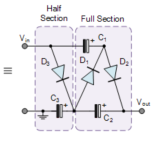Greeting all, I'm having trouble planning a circuit with a 0-135v secondary 230ma into a voltage tippler and a tube rectifier. I have never used a doubler or a tippler before
and am a little confused how to wire this up with the tube rectifier. Thanks in advance for your help!
and am a little confused how to wire this up with the tube rectifier. Thanks in advance for your help!
You will need three diodes with isolated heater windings (three GZ34 wired as a single diode or better etc) and follow this simple circuit.
Edit; suggested rectifier added
Edit; suggested rectifier added
Attachments
Last edited:
You should give a bit more info if you expect a response. What do you mean by 'a little confused'?
Schematic of your doubler/tripler (not tippler) and how you intend to do it?
Or do you need help with the basics of a doubler? Or with the specifics of a tube rectifier after a doubler/tripler and its heater wiring?
Note that a doubler or tripler delivers a DC voltage with ripple, just as a regular rectifier, so you should not need the tube rectifier.
A drawing is worth 1000 words.
Jan
Schematic of your doubler/tripler (not tippler) and how you intend to do it?
Or do you need help with the basics of a doubler? Or with the specifics of a tube rectifier after a doubler/tripler and its heater wiring?
Note that a doubler or tripler delivers a DC voltage with ripple, just as a regular rectifier, so you should not need the tube rectifier.
A drawing is worth 1000 words.
Jan
Last edited:
Odd-numbered voltage multipliers are the worst for ripple, so a tripler is not good, for all that they were used in colour televisions for the EHT. Also, multipliers are for very low currents only; you do not get something for nothing. They produce a lot of ripple and they have a much higher output resistance than more conventional rectification, so their output voltage collapses when you put a load on them. If that sounds as though I'm trying to put you off, it's because I am. Voltage multipliers make sense when you need kV or when you have negligible current draw (like the polarising voltage on an electrostatic loudspeaker).
Voltage multiplayer is a bad idea for audio, especially with rectifier tubes. He should get a suitable transformer and forget about such ideas.
- Home
- Amplifiers
- Tubes / Valves
- Voltage tripler and a tube rectifier
